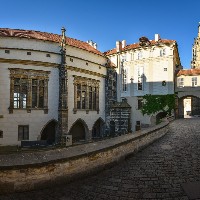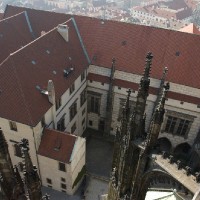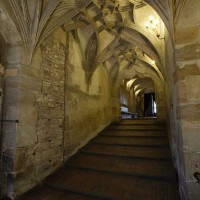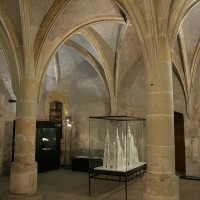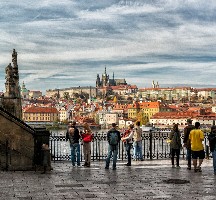Breadcrumbs navigation
Prague Castle - Old Royal Palace (Starý královský palác)
This palace was the seat of Bohemian princes and kings until the 16th century. It was built on the remains of the Romanesque Soběslav Palace. Most notable is the Gothic Vladislav Hall – the largest secular space of medieval Prague (1487 – 1500, Benedikt Rejt) with remarkable rib vaulting, used today as the venue for ceremonial state events. Entry to the Palace is included in the Prague Castle guided tour.
- Monuments & Architecture
- palace
- Romanesque
- Gothic
- Renaissance
- Prague Visitor Pass
Opening hours
-
- September – March
- Whole week
- 09.00 – 16.00
-
- April – October
- Whole week
- 09.00 – 17.00
Practical information
The oldest part of the Prague Castle complex. Parts accessible to visitors include the New Land Table rooms, Vladislav Hall, All Saints’ Church, Equestrian Staircase, Theresian Wing, Imperial Court Council Chamber, and Charles Hall.
- This is included in the price of admission for the Basic Tour of Prague Castle.
(Admission: standard CZK 450 | concessions CZK 300 | family CZK 950)
The Old Royal Palace may also be visited as part of the following guided tours of Prague Castle:
- Old Royal Palace Up Close, including the Green Room, the Small Audience Hall of Vladislaus II of Hungary, the Vladislav Hall, and adjacent areas
- Romanesque and Gothic Floors of the Old Royal Palace, including the Romanesque hall and the Gothic halls on the lowest floors of the Old Royal Palace
Booking system for currently advertised tours at Prague Castle
*
A permanent exhibition entitled The Story of Prague Castle is installed on the Gothic level.
This is included in the price of admission for the “Prague Castle – Permanent Exhibitions” tour, i.e. Prague Castle Picture Gallery + Story of Prague Castle Exhibition + Mihulka Powder Tower (Castle Guard Exhibition) + Rosenberg Palace
(Admission: standard CZK 300 | concessions CZK 200 | family CZK 700)
The Story of Prague Castle – Permanent Exhibition
A unique project informing the general public about the history of Prague Castle, from prehistory to the present day. Visitors will see models of Prague Castle from the various stages of its development, copies of the Bohemian crown jewels, and many exhibits from the Castle collections.
Contacts
- Prague Castle - Old Royal Palace (Starý královský palác)
- Pražský hrad
- 119 08 Praha 1 – Hradčany
- +420420224372434
- +420224372423
Programme
Object history
It is a composite building complex representing the historical royal residence in several stages
The Romanic underground area is the oldest part of the palace. There are four premises of Soběslav’s Romanic palace built after 1135 at the level of the second basement:
- former passage way through the Southern spired gate, which used to be a part of the castle’s fortifications,
- remains of rampart fortifications,
- former ground floor of the palace with a barrel-vaulted hall and small windows,
- bottom floor of the Romanic Chapel of All Saints.
The Gothic floor (1st basement of the current palace) includes the following premises:
- arcades from the era of Charles IV, walled up during the reign of Václav IV, three of them were revealed after 1930
- The room of Old Municipal Files from the era of Přemysl Otakar II, the heavy vault of which leans against two low barrel columns. The room was used as a deposit for property records of the nobility and for resolutions of the municipal court (the documents burned during the 1541 fire of the Castle).
- Charles’ Hall with additionally built in vault. There are mighty pillars traversing through the premises, carrying the vault of Vladislav’s Hall (Vladislavský sál), built above the Charles’ Hall.
- Old Register Office for the bills of the Bohemian Chamber. From here, a passage leads to
- Column Hall of Václav IV from around 1400, the most remarkable Gothic room, originally used as a residence. Its large windows complemented by seats originally overlooked the 3rd courtyard, which, however, is much higher today, so it is possible to enter the archaeological excavations under the courtyard from one of the windows.
- The Room of Royal Files is accessible from the Column Hall. It was used as a depository of the Royal Files (resolutions of the Royal Court). There is already a Renaissance vault in the room.
Since the 6th April 2004, a new permanent exposition has been installed on the Gothic floor named The Story of Prague Castle. The main part of the exposition represents history, events, personalities, arts and crafts of the castle premises from pre-history until present days. This route takes up the premises of the Gothic floor in the Old Royal Palace, and the installed models show Prague Castle in the respective development stages and are completed by small extraordinary items (oldest, most precious etc.). The timeline of the exhibition is followed by smaller exhibitions connected by one theme - the actual Stories (The story of Bohemian patrons, The story of the Church and the cathedral, the Story of burials, the Story of the residence, The story of the dining, The story of education, The story of catastrophes). The exhibition is complemented by a programme for children named “Castle Game” and different interactive programmes.
The representative floor of the Old Royal Palace consists of the following premises:
- Vestibule and the Green Room originally with a Gothic vault. The Green Room used to be a place for sessions of lesser courts, and of the Royal and the Chamber Court after 1512. It is decorated with emblems of the Chamber Court officials from the 18th century. On the walls, there are preserved fragments of the municipal emblems. On the ceiling, there is a Baroque fresco transferred to this room from the Supreme Burgrave’s House (Nejvyšší purkrabství) in 1963.
- Vladislav’s Small Audience Chamber from an era before 1490 with decorative late-Gothic vault and municipal emblems on the bosses. The walls are decorated by the emblems of the kingdom’s supreme hofmeisters from the 16th century.
- Vladislav’s Hall, built in the years 1492 - 1502 by Vladislav of Jagiellon according to a project of Benedikt Ried. It was the largest profane space in medieval Prague with the proportions of 62 x 16 x 13 metres. The most remarkable features are the net vault of a stellar type and the windows more than 5 m high in both the Southern and the Northern wall, which are on of the first documents of Renaissance in our territory. Wooden floor probably dates back to 1791 and out of five chandeliers, three are originals made of tin, dating back to the 16th century. Knights’ tournaments used to be held in the Hall, as well as balls, assemblies, court sessions, bazaars, banquets, etc. The knights on horses coming for the tournaments would enter via a Riders’ staircase. Today the presidential elections and festive state events are held in the Hall.
From the corner of Vladislav’s Hall, there is an entrance to the Renaissance, so called Ludvík’s Wing, which was built above the castle rampart in a direction towards the town, probably according to a project of Benedikt Ried in the years 1503 - 1520 by Vladislav and Ludvík of Jagiellon. To be found here, there are:
- two rooms of the Bohemian Office, which would represent the king in case of his absence. The room in the back is known for the second Prague defenestration from 1618, when two governors, Jaroslav Bořita of Martinice and Vilém Slavata of Chlum, were thrown out of the window together with their secretary Filip Fabricius (all survived). This defenestration initiated Bohemian Estates Uprising and subsequently the Thirty Years’ War.
- Imperial Court Council Room, situated on the floor above the Bohemian Office, has a purely Renaissance interior and large windows. The office furniture and tile stove date back to the 17th century. On the walls, there are portraits of Bohemian kings from the Habsburg family.
- Observation Terrace offers beautiful view of the city and the Garden on the Ramparts (Na Valech). Next to the observation spot, there is a spiral granite staircase made by Otto Rothmayer, which connects the Old Royal Palace with the Theresian Wing.
- Theresian Wing is a narrow tract built by Maria Theresa in 1766 - 1768 as a connection between Ludvík’s Wing and the Institute for noble women. Its top floor was removed in 1931 as it blocked the view of the Vladislav’s Hall front.
- Rooms of the New Municipal Files adjoin the Northern side of the Vladislav’s Hall. They were used by the officials working with the municipal files from the 1560s on. Their painted emblems decorate the walls, as well as the vaulted ceiling. Carved wardrobes from the era of Rudolf II are installed here.
- Assembly Hall from the mid-16th century, built according to a historicist project of Bonifác Wohlmut. There is a decorative ribbed vault in the room, and there is a platform of the supreme scrivener in an elevated place, interconnected with the premises of the new municipal files. There is assembly furniture for the king, the archbishop and other representatives of the church, for the representatives of the estates and the knights, the representatives of the royal towns, for the supreme municipal officials and judges. On the wall, there are portraits of Maria Theresa and her husband, Joseph II, Leopold II and Franz II.
- Riders’ Staircase was once used as the entrance for knights riding horses and coming for the tournaments in Vladislav’s Hall, and today it is used to exit the hall. It was built around 1500 by Benedikt Ried. The actual staircase is made up of 9 low steps, it is 3.5 m wide, and 8.35 m long. There is a complex helical vault with intersecting ribs on the floor.
- All Saints’ Church built by Petr Parléř after 1370 in place of a Romanic palace chapel. After the fire in 1541, only the enclosure walls were preserved. It was rebuilt and modified in Renaissance style only in 1580. At the same time, it was extended all the way to Vladislav’s Hall, with which it is connected via one of the portals. The main altar is Baroque, carrying a painting of All Saints by Václav Vavřinec Reiner from 1732. There are 12 pictures from the Legend of St. Prokop by Kristián Dittmann from 1669. The last one depicts the transfer of St. Prokop’s remains from the Sázava Monastery to the All Saints’ Church in 1588, in which they were buried. St. Prokop’s Baroque tombstone is surrounded by allegoric statues of Virtue and reliefs from St. Prokop’s legend. A triptych on the altar of St. Archangels is probably the piece of Hans von Aachen.
Prague Castle has been a National Cultural Monument since 1962.
Information source: www.hrad.cz

